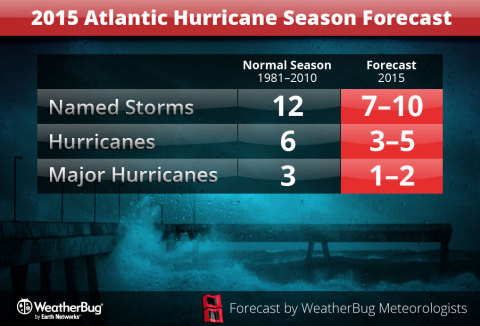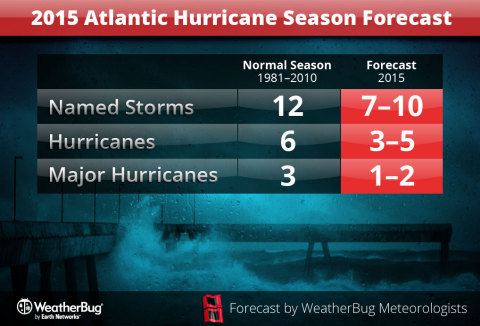GERMANTOWN, Md.--(BUSINESS WIRE)--Following a quiet 2014 Atlantic hurricane season that brought a total of eight named storms, six hurricanes and two major hurricanes, the Meteorology Team at WeatherBug forecasts a similar outlook for the 2015 Atlantic hurricane season, with average-to-below-average storm activity.
While NOAA designates June 1 through November 30 as the “official” hurricane season, storms do form outside those dates. The Atlantic hurricane season kicked off to an early start when its first named storm, Ana, formed on May 7. The season includes activity in the Atlantic Ocean, Caribbean Sea, and the Gulf of Mexico.
The WeatherBug Atlantic Hurricane Season Outlook includes the following predictions:
- Tropical Outlook: The 2015 Atlantic hurricane season forecast is for 7-10 named storms. By comparison, the years from 1981 to 2010 averaged 12 named storms. The years from 1995-2012 have been more active, averaging about 15 named storms. The 2013 season was unexpectedly tame, with no hurricanes above a Category 1 on the Saffir-Simpson scale.
- Hurricane Outlook: Three to five of these storms could become hurricanes with sustained winds of 74 mph or higher. One to two of those may become strong enough to be considered a “major” Category 3 hurricane with winds in excess of 110 mph. In comparison, 1981 to 2010 averaged about six hurricanes and two major hurricanes. Seasons from 1995-2012 showed increased activity, averaging about eight hurricanes and three major hurricanes per year.
- U.S. Landfall Threat: A below-average potential for hurricane landfall in the U.S. does not mean it will be a safe season. It only takes one landfall to destroy lives and livelihoods: In 2011, Hurricane Irene was the only hurricane that reached the U.S., yet killed 56 and caused more than $16 billion in damages. In October 2012, Hurricane Sandy directly claimed nearly 70 lives in the U.S. and caused $65 billion in damages.
Why are meteorologists forecasting another quiet Atlantic hurricane season? Senior Meteorologist John Bateman explains, “El Niño -- the abnormal warming of the Pacific Ocean near the equator -- is occurring and all expectations are for it to continue and possibly intensify through the summer. As El Niño tends to inhibit tropical development in the Atlantic, it is a key factor for our forecast for the 2015 season and the reason behind our below-normal tropical storm prediction.”
The National Oceanic and Atmospheric Administration (NOAA) will issue its outlook on May 27.
About the WeatherBug Atlantic Hurricane Forecast
Every spring, the WeatherBug Meteorology team at Earth Networks evaluates historical and breaking weather information to forecast the likelihood and intensity of tropical storms and hurricane activity in the Atlantic Ocean and Gulf of Mexico. The team examines global atmospheric and oceanic temperatures and trends, the state of the El Niño - La Niña Southern Oscillation, various climate indices, and long-term computer forecast models.
Be Prepared, Stay Informed
Americans living near the Gulf of Mexico and Atlantic Coast must prepare now for the upcoming hurricane season. Visit the WeatherBug Hurricane Center to learn how to prepare. Turn to the WeatherBug for the latest weather in your neighborhood, severe weather alerts, and 2015 hurricane season coverage. Get updates anywhere on Twitter at http://twitter.com/WeatherBug.
About Earth Networks: Powering WeatherBug & WeatherBug Home
For 20 years, we have been Taking the Pulse of the Planet® using the world’s largest weather, lightning and greenhouse gas monitoring networks. Our sensors across the planet keep consumers, businesses, and governments informed, updated and alerted. Our popular WeatherBug® brand provides neighborhood-level weather, superior forecasts and advanced severe weather alerts to millions. Our WeatherBug Home offering taps big weather and connected home data for improved energy efficiency and comfort. Enterprises such as schools, airports, professional sports teams, utilities and government agencies rely on our early warning solutions to safeguard lives, prepare for weather events, and optimize operations. Know Before®.




